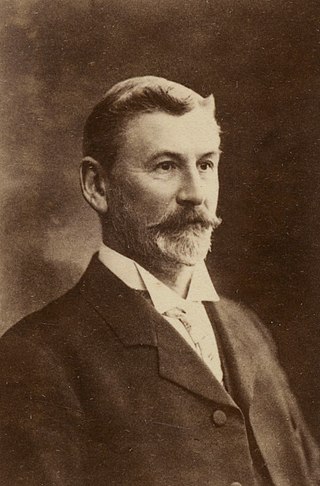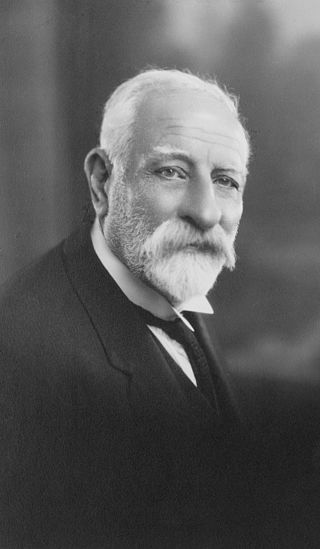Related Research Articles
Laura is a rural town in the Mid North region of South Australia, 12 km north of Gladstone on the Horrocks Highway and 40 km east of Port Pirie. The first European to explore the district was Thomas Burr in September 1842. His promising reports soon led to occupation of the district by pastoralists, one of whom was Herbert Bristow Hughes. When the present town was surveyed he named it for his wife, Laura née White.

Palmer is a town just east of the Adelaide Hills region of South Australia along the Adelaide-Mannum Road, 70 kilometres east-north-east of the state capital, Adelaide and 15 km west-north-west of Mannum. It is located in the Mid Murray Council local government area. At the 2006 census, Palmer had a population of 329.
Frank Andrew Halleday was an Australian politician. He was a member of the South Australian Legislative Council from 1938 to 1943.

Heinrich Albert Alfred von Doussa was an Australian businessman and politician. He was a member of the South Australian Legislative Council from 1901 to 1921, representing Southern District.
William Bowman was a pioneer farmer, grazier, flour miller and merchant on the Finniss River near Middleton, South Australia.
Charles Morris Russell Dumas, generally referred to as Charles M. R. Dumas, was a South Australian newspaper proprietor and politician. He was the proprietor of The Mount Barker Courier and Onkaparinga and Gumeracha Advertiser for 54 years and served as president of the South Australian Provincial Press Association from 1915 until his death. He was a member of the South Australian House of Assembly from 1898 to 1902, representing the electorate of Mount Barker.
Charles Richard Wilton was a journalist in the State of South Australia, a longtime literary editor of The Advertiser and authored, under the pen name of "Autolycus", a long-running weekly column in The Courier of Mount Barker.
Sir Frederick Lloyd Dumas, generally known as "Lloyd Dumas" or "F. Lloyd Dumas", was a journalist and politically influential newspaperman in Victoria and South Australia.

John Baxter Mather was a Scottish born journalist, newspaper proprietor, landscape painter and art critic in South Australia.
Quiz was a weekly newspaper published in Adelaide, South Australia from 1889 to 1910. Between 1890 and 1900 it was known as Quiz and The Lantern.
Maurice William Parish was an Australian politician who represented the South Australian House of Assembly multi-member seat of Murray from 1915 to 1918. He was elected at as a United Labor Party member, left the party to join the National Party in the 1917 Labor split, and became an independent in 1918.
The Australische Zeitung was a weekly German-language newspaper published in Tanunda, South Australia from 1860 until it ceased publication during World War I in 1916 due to anti-German sentiment. The newspaper also existed in a variety of earlier names or merged publications, reflecting the fluid nature of the newspaper industry in Victorian gold rush era colonial South Australia. The long history of German language Australian newspapers reflects the considerable German-speaking population which settled in South Australia in the nineteenth century.
The Corporate Town of Murray Bridge was a local government area in South Australia from 1924 to 1977.
The Adelaide Chronicle was an early publication in Adelaide, the capital of the then colony of South Australia. It was published between 1839 and 1842, when it ceased publication as a result of the economic depression caused by the mass exodus of workers to the Victorian goldfields.
Carl Heinrich Conrad Loessel or Lössel, generally known as Carl or Carl Heinrich Loessel, was a German-born Lutheran pastor and schoolteacher in the early days of the British colony of South Australia. He was a founder of the Lutheran Church in Flinders Street, Adelaide, and pastor of the church at Lobethal.
Cowirra is a locality in the Murraylands region of South Australia. It is on the left (east) bank of the Murray River, opposite Mannum.
Dora Cecil Chapman, also known as Dora Cant, was a painter, silk-screen printer, potter and art teacher. A resident of South Australia, New South Wales, and England, she was concerned with changing society through social realist art.
Cox Creek, also Cox's Creek, previously Cock's Creek, is a small stream in the southern Adelaide Hills. Cox's Creek was also the name of the settlement which became Bridgewater, South Australia.

The PV Pyap is a tourist paddle vessel operating within Swan Hill's Pioneer Settlement. Originally launched as a barge in July 1896 at Mannum, the Pyap was completed as a paddle steamer in late 1897 and operated on the Murray River. In 1970, the Pyap was purchased by Toby Henson and refitted with a diesel enginge, with the intention of relocation to the Pioneer Settlement.
References
- ↑ Front page of the first issue.
- ↑ "A Word for Ourselves". The Mount Barker Courier and Onkaparinga and Gumeracha Advertiser . SA: National Library of Australia. 24 November 1893. p. 2. Retrieved 27 December 2014.
- ↑ "SA Memory - Mannum mercury and farmers' journal". www.samemory.sa.gov.au. Retrieved 24 August 2018.
- ↑ "The Courier Changes Hands". The Mount Barker Courier and Onkaparinga and Gumeracha Advertiser . SA: National Library of Australia. 5 May 1938. p. 2. Retrieved 26 December 2014.
- ↑ "Advertising". The Mount Barker Courier and Onkaparinga and Gumeracha Advertiser . SA: National Library of Australia. 12 February 1909. p. 2. Retrieved 27 December 2014.
- ↑ "Newspaper Proprietor Retires". The Mount Barker Courier and Onkaparinga and Gumeracha Advertiser . SA: National Library of Australia. 4 April 1946. p. 2. Retrieved 26 December 2014.
- ↑ "Our Hills History". The Mount Barker Courier and Onkaparinga and Gumeracha Advertiser . SA: National Library of Australia. 18 October 1951. p. 8. Retrieved 27 December 2014.
- ↑ "Ourselves". The Mount Barker Courier and Onkaparinga and Gumeracha Advertiser . SA: National Library of Australia. 30 October 1952. p. 3. Retrieved 27 December 2014.
- 1 2 Adams, Prue (28 May 2020). "As coronavirus shuts down regional news, this 91-year-old Adelaide Hills newspaper editor keeps printing". ABC News. Australian Broadcasting Corporation. Retrieved 1 June 2020.
- ↑ "Our Hills History". The Mount Barker Courier and Onkaparinga and Gumeracha Advertiser . Vol. 71, no. 3062. South Australia. 27 September 1951. p. 5. Retrieved 29 March 2019– via National Library of Australia.
- ↑ "SA Memory:SA Newspapers : Pen names of South Australian journalists and cartoonists". SLSA. 16 February 2009. Retrieved 29 March 2019.
- ↑ "Departure of a Prominent Townsman". The Mount Barker Courier and Onkaparinga and Gumeracha Advertiser . SA: National Library of Australia. 8 February 1889. p. 2. Retrieved 26 December 2014.
- ↑ "Death of Mr. C. R. Wilton. A Notable Journalist". The Mount Barker Courier and Onkaparinga and Gumeracha Advertiser . SA: National Library of Australia. 11 March 1927. p. 2. Retrieved 27 December 2014.
- ↑ "Our District". The Mount Barker Courier and Onkaparinga and Gumeracha Advertiser . SA: National Library of Australia. 2 August 1889. p. 3. Retrieved 26 December 2014.
- ↑ "Metropolitan Memoranda". The Mount Barker Courier and Onkaparinga and Gumeracha Advertiser . SA: National Library of Australia. 3 November 1911. p. 3. Retrieved 26 December 2014.